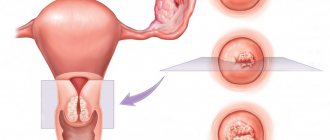Cancer - what is it?
Cancer is a tumor that occurs as a result of the continuous division of a cell that has gotten out of control. This process cannot be stopped. Cancer affects more and more healthy cells, which also begin to divide. Diseased cells are carried through the bloodstream and lymph flow throughout the body. This is how metastases arise with new foci of malignant tumors. In fact, cancer behaves in the human body like a virus, extremely dangerous and very aggressive.
https://youtu.be/UFI59_CkVpw
Stage four cancer
Stage 4 cancer is the terminal stage of cancer. In most cases, the first stages of cancer are asymptomatic, and when symptoms of a malignant tumor appear, it is most often at an advanced stage of development. Very often, a tumor develops rapidly in a short period of time—certain factors influence the rate of cancer development. The rate of cancer development can be affected by pregnancy, stress, injury, age, and type of cancer. The fourth stage of cancer can no longer be cured with surgery due to the spread of the tumor process. The neglect of the process does not allow the patient to be cured, but modern medicine makes it possible to extend the patient’s life by several months or years.
The plague of the 21st century is cancer
Today, we can say with full responsibility that cancer is the plague of the 21st century. Most likely, each of us has encountered this terrible disease in one way or another. Some friends have fallen ill, others have relatives or loved ones, and others themselves suffer from this terrible illness. Most of us think that if a person is sick, then death from cancer is inevitable. But this is not entirely true, because a lot depends on the form of the disease and the stage of its development at the time of detection. The sooner a patient seeks help, the greater the chance of saving him or prolonging his life as much as possible.
The situation is that about 14 million people worldwide get cancer every year. Deaths from cancer are in second place after deaths from diseases of the cardiovascular system. And, unfortunately, this number is growing every day. Why is this happening? And what determines the occurrence of this terrible disease? Let's figure it out.
Notifications
The second point is that despite the organ-preserving volume, pregnancy occurs independently only in 30-40% of cases. In the rest, the use of assisted reproductive technologies (ART) is desirable. These are in vitro fertilization (IVF) and embryo transfer. Therefore, it is advisable to carry out all this in a specialized clinic. And then - delivery by cesarean section, and subsequent removal of the uterus is not required. It is even possible to become pregnant again.
V.N.:
We have such a patient. She underwent treatment, gave birth and is thinking about another pregnancy.
“It feels like right now we are on the verge of some decisive turning point in the treatment of cancer in women. To summarize, what is important to note so as not to reassure in vain and not to deprive hope?
K.M.:
The surgeon must understand how much surgery needs to be performed. Otherwise, the risk of recurrence of the disease increases. The second point is a good morphological service, which will help assess the true spread of the tumor. Third is continuity. Unfortunately, most obstetricians and gynecologists do not know what to do with such women. They are not ready to plan their pregnancy or apply a cerclage, so they have to refer such women to specialized centers. Even in Moscow there are problems with this.
V.N.:
It seems to me that it is more important to say that you need to go to the gynecologist, and do it regularly, and not just during pregnancy. Next, you must definitely clarify whether your gynecologist takes a cytology test from your cervix, and not just flora, as is often the case. Unfortunately, the system of calling for screening in Russia has not been worked out, so women themselves must be conscious. Taking smears yourself for cytology every two years is not difficult. Plus - ultrasound and mammography.
Signs of imminent death from cancer. The patient's feelings
Unfortunately, cancer is a disease that, before the death of the patient, most often makes him experience quite painful sensations, both from the treatment and from the disease itself. Manifestations may vary, depending on which organ is damaged initially or by subsequent metastases, but there are a separate series of signs of approaching death. They are the same for all cancer patients.
- The most common signs of death from cancer are constant sleepiness and fatigue. A person no longer has the strength to stay awake. This occurs due to a slowing metabolism. Since the body lacks the nutrition it needs, it seems to go into hibernation.
- Loss of appetite. Cancer very often does not allow patients to even drink water. The body becomes so weakened that it simply does not have enough energy to digest food.
- Heavy and hoarse breathing. This is a fairly common symptom of impending death from cancer.
- Very strong weakness. Sometimes a dying patient does not even have the strength to turn on his side.
- Complete or partial disorientation. Death is already close. Organs begin to fail, the brain dies.
- Extremities get cold. Just before death from cancer, blood rushes to vital organs, leaving the periphery.
- The patient loses interest in the world around him and almost completely withdraws into himself.
- If there are metastases, and in the last stages of cancer almost all patients have them, the patient begins to feel very severe pain in the bones.
- The appearance of venous spots warns of imminent death. Sometimes gangrene can even develop. Also, problems with hematopoietic function can lead to anemia or even a stroke.
- People dying of cancer very often experience paralysis of the limbs just before death.
- Vomiting, hallucinations, and severe weight loss may be signs of imminent death from cancer. But it is quite possible that they are side effects of aggressive treatment.
Lungs' cancer
This is the most common type of cancer. Death from lung cancer ranks perhaps first among all deaths from cancer. The fact is that this disease is practically asymptomatic, and often it can only be detected in the final stages, when it is too late and practically nothing can be done.
The patient experiences severe pain when breathing. And the closer the death, the more noticeable these pains are. Inability to breathe, every breath is difficult. A debilitating cough and a constant feeling of lack of air, headaches, dizziness, and even epileptic seizures are possible. It happens that the bones of the back and hips begin to ache.
Cancer is treated mainly with chemotherapy, radiation therapy, and surgery, as well as a combination of these three methods. There are many alternative types of treatment, but their effectiveness has not been proven.
Liver cancer
It is divided into primary and secondary types. The first is when a malignant neoplasm arises from degenerated cells of the liver itself. It is extremely rare, only in 10% of cases out of 100. But the so-called secondary type develops from cancer cells brought from the original tumor along with the bloodstream.
The liver is one of the organs most affected by metastases. The main reason for the development of hepatoma is cirrhosis of the liver. Its main prerequisite is alcohol abuse. Viral hepatitis B, diabetes, and the influence of various carcinogens on the liver also contribute to the development of primary liver cancer. Men are significantly more likely to develop hepatoma than women. In addition to congenital sex predisposition, this is influenced by the use of drugs such as steroids to build muscle mass.
Death from liver cancer is always painful, the cancer progresses very quickly, and the person “burns out” literally before our eyes, without having time to wait for a transplant, which, moreover, is only possible in the early stages of the disease. The pain begins in the area of the right hypochondrium, weakness appears, appetite decreases, nausea and vomiting begin. The temperature rises, and the pain intensifies and becomes literally unbearable. Before dying from liver cancer, the patient suffers greatly. Patients with hepatoma are considered incurable by default.
Uterine cancer
This cancer, which ranks fourth in incidence among other types of cancer, is almost painless. Noticeable pain begins only at stages 3–4, so very often uterine cancer is diagnosed in an extremely advanced form. The main symptoms are pain, bleeding during the cycle and during sexual intercourse, as well as during physical activity. The very first signs of cancer at an early stage are intense mucous discharge with purulent inclusions and an unpleasant odor, which causes itching and burning. Symptoms can be either temporary (periodic) or permanent.
More than six thousand women a year expect to die from uterine cancer - this is 60% of cases. These are mainly women from 20 to 45 years old.
Cervical cancer stage 4
The tumor spreads rapidly, consuming nearby tissues and capturing new distant territories. Stage 4 cervical cancer is almost always the presence of metastatic lesions. Late stage carcinoma is divided into the following variants:
- The tumor leaves the boundaries of the bony pelvis, reaching the mucous membranes of neighboring organs (bladder, ureters, rectum);
- Germination into adjacent organs;
- Presence of distant metastases.
Metastatic cancer with an initial cervical tumor is formed in 4 directions:
- Vaginal (vaults and walls of the vagina);
- Uterine (muscular wall of the organ);
- Parametric (fiber around the uterus);
- Lymphatic (iliac lymph nodes).
From distant organs, metastases are most often found in the following structures:
- Liver;
- Kidneys;
- Bones;
- Lungs.
Detection of metastatic foci is always stage 4 cervical carcinoma, even if the size of the primary lesion corresponds to the tumor focus at stage 1 (up to 2 cm).
Mammary cancer
This cancer occurs in women. The main reasons for the development of cancer in the mammary glands are various hormonal disorders that are associated with improper use of oral contraceptives, abortion, various inflammatory diseases of the ovaries and uterus, excess body weight, lack of vitamins and microelements due to improper dietary nutrition, as well as irregular sex life.
Death from breast cancer is a fairly rare occurrence, and most often this outcome can be avoided due to early detection of the tumor. Its symptoms are extremely pronounced: a strong increase in body temperature, general weakness, dizziness, muscle pain. All this is accompanied by an increase in one of the breasts by more than 2 times and possible purulent discharge. It is also easy to detect nodular painful formations in the chest, which can be easily palpated by palpation. When treating a tumor, loss of the affected mammary gland is most often inevitable.
Last way
If a patient is diagnosed with stage 3–4 cancer, then the patient is not kept in the clinic, he is discharged home. Despite the huge number of different painkillers, dying from cancer is a rather painful process. By this time, the body is usually already affected by numerous metastases, and new tumors begin to make themselves felt. It is good when the patient sleeps most of the time or is in a coma. Perhaps in this state he does not suffer from pain. Yes, special hospices have been created in cities for such doomed people, but not everyone can get there. It is only in our power to somehow alleviate the suffering of a person close to us at this last stage of a terrible and most often fatal illness.
Lifespan
Many women think: I have stage 4 uterine cancer, how long do they live with this stage? For each sick person, this period is individual. Unfortunately, the fourth stage is extremely unfavorable for the patient, regardless of her age. In most cases, this is due to the progressive growth of metastases.
A large number of people think that if the last stage of the disease has arrived, it means that the girl has very little time left to live. This is absolutely not true. If a representative of the fairer sex fully complies with the specialist’s prescriptions and undergoes full comprehensive treatment, then her life expectancy can increase by five years.
The chance of survival can depend only on two indicators:
- From the chosen treatment;
- From the severity of the disease.
Unfortunately, with the fourth degree, no more than 10% of patients will be able to live five years longer than other sick women. The duration is also affected by age, diseases that were previously suffered, surgical interventions and the general condition of the body.
It is worth noting that medicine has not stood still lately. Scientists have made significant progress. They develop medicines using a new modern method with increased efficiency. Each time the treatment methods become more and more productive.
For early warning of the disease, the girl is offered to take a smear test from the cervical canal. This medical examination allows us to detect stage 4 uterine cancer, when it is completely asymptomatic.
Other European countries have gone ahead and are forcing all representatives of the fairer sex, regardless of their age, to be vaccinated against papillomavirus. For this purpose, special vaccines have been developed that have a positive effect.
Unfortunately, in most cases, girls seek help only when the cancer reaches an advanced stage and it will be impossible to cure it. At such moments, doctors can only offer chemotherapy, which will give a slight positive effect and improve the patient’s quality of life.








